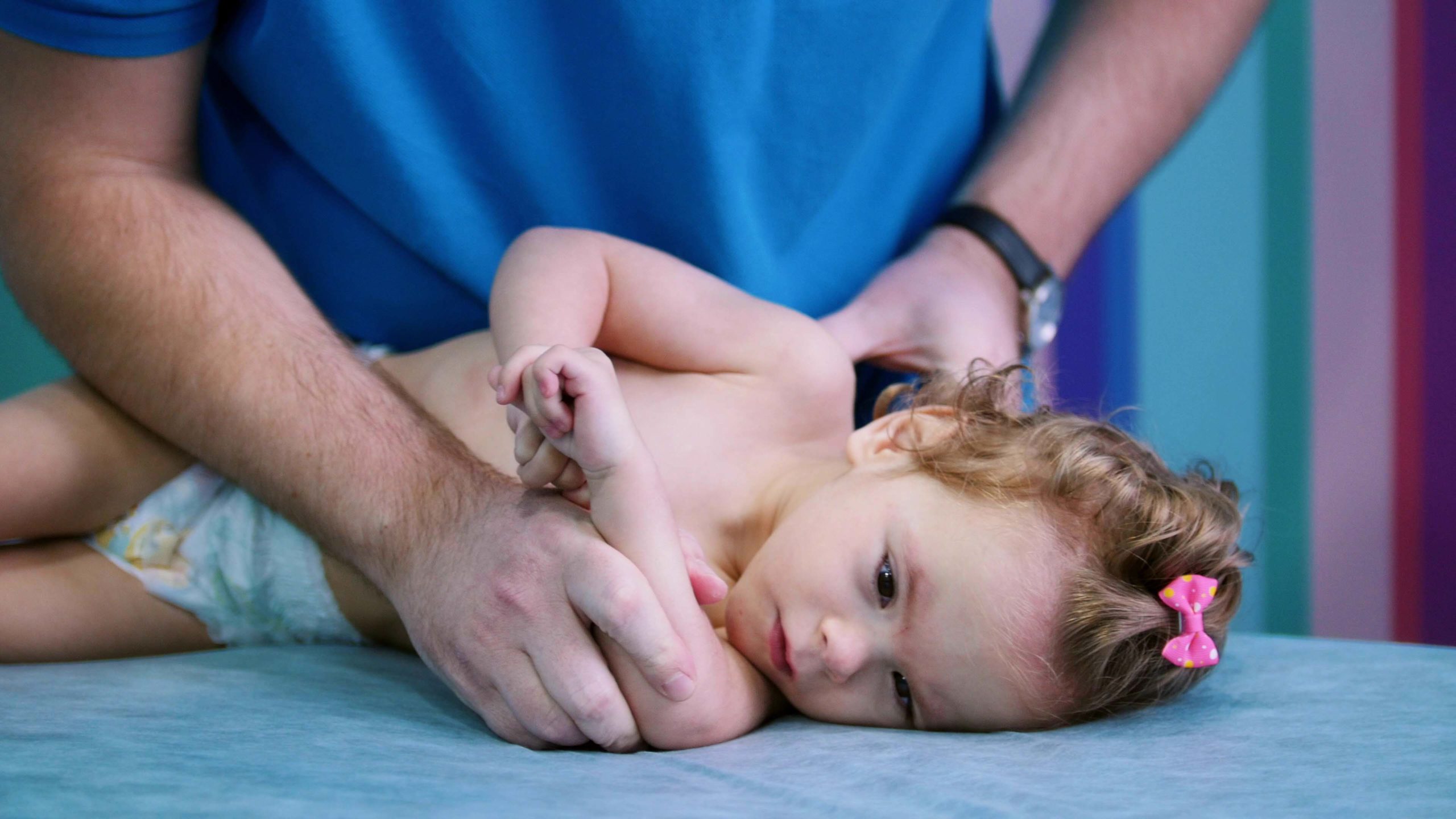Cerebral Palsy Lawyers in Canada
“Our son suffered a brain injury at birth which resulted in a diagnosis of Cerebral Palsy... As a result of the incredible work of Hilik & Sommers and Roth we now have the financial resources to truly take care of our son, the way we want to! He can receive all the therapies and educational support he needs, to optimize his potential...despite his diagnosis. Our son’s financial needs will be taken care of for life, which is a relief beyond words.” – SRE Client
Cerebral Palsy Lawyers

Cerebral palsy (“CP”) is a term coined by Dr.William Osler describing a group of permanent movement disorders leading to difficulties with speaking, eating, seeing, walking, or performing other everyday tasks caused by abnormal brain development or brain injury.
Cerebral palsy manifests itself in early childhood. Individuals with CP may also suffer from developmental delay, intellectual disability, behavioural problems, learning disabilities, poor adaptive skills, scoliosis, and often suffer from secondary syndromes such as seizure disorders. Symptoms may include poor coordination, weak or stiff muscles, and tremors or seizures.
A common misconception is that cerebral palsy is inevitable or genetic. In fact, in a very large proportion of cases, cerebral palsy is caused by a specific brain injury, often at birth. Even if treating physicians believe that a child’s CP is genetic, a thorough investigation of the pregnancy, labour and delivery may prove that the ‘genetic’ label is incorrect. If you had complications during your pregnancy, labour and delivery, or birth, and your child suffered a brain injury such as cerebral palsy, you may have legal recourse.
For over 40 years, the dedicated medical malpractice lawyers at Sommers Roth & Elmaleh have been helping patients and families affected by birth injuries or medical negligence, and especially cerebral palsy. We have set ground-breaking legal precedents and have regularly been at the forefront of developments in medical malpractice litigation. We are consistently recognized by both the legal and medical community as being among the top medical malpractice lawyers in the country.
Cerebral Palsy Due to Medical Negligence
The most common cause of cerebral palsy due to birth injury is oxygen deprivation (hypoxic insult) to the brain of the newborn during the labour and delivery/childbirth process (intrapartum). Cerebral palsy can also be caused by malformation or damage to the brain during pregnancy or immediately after birth during the neonatal period. A fetus’ brain oxygen can be restricted in a number of ways, including constriction or occlusion of the umbilical cord, constriction of the neck, pressure on the cranium or skull, poor oxygen exchange in the placenta, or other trauma.
The additional stresses of labour may exacerbate these issues or even cause them, making it crucial for doctors and nurses to monitor the fetus throughout the labour process by monitoring the fetal heartrate using an electronic fetal monitor (EFM), shift the fetus if needed to prevent constriction, and, where necessary, to perform a timely C-section.
In cases of fetal distress or a high-risk birth, the neonatal team should be called. If the baby isn’t breathing, a Code Pink or Code Blue should be called immediately on delivery. If a baby is delivered ‘flat’, with low APGAR scores or acidosis, common neonatal interventions include intubation of the airway, suction of meconium, resuscitation, mechanical ventilation, administering sodium bicarbonate and epinephrine, and brain cooling (therapeutic hypothermia) protocols. If the baby experiences seizures, anticonvulsant medications, such as phenobarbital, dilantin, and Lorazepam/Ativan, are administered.
Neonates (newborns) with cerebral palsy often experience sequelae (or symptoms) of brain dysfunction shortly after birth called neonatal encephalopathy or hypoxic-ischemic encephalopathy (HIE). This manifests in low APGAR scores (hypotonia, depressed reflexes, decreased consciousness, absent Moro’s reflex, difficulty respiring, poor colour and low heart rate) and seizures. The ‘SARNAT’ classification scale is a tool used to measure the severity of HIE, ranging from SARNAT 1 (mild) to SARNAT 3 (severe).
Developments in delivery practices have made the process of childbirth safer, and have decreased the number of children with cerebral palsy, but mistakes are still made by obstetricians, other doctors, midwives, nurses, and other healthcare professionals which can permanently affect children.
Risk factors during pregnancy for encephalopathy and/or cerebral palsy include maternal hypothyroidism, intrauterine growth restriction (IUGR) or small for gestational age (SGA), hypertension or preeclampsia, oligohydramnios and polyhydramnios and uteroplacental insufficiency, among others.
Common Problems During Labour and Delivery
Common problems during labour and delivery (intrapartum) that can have a lasting impact on your child include:
- Breech presentation;
- Perinatal or birth Asphyxia or hypoxia-ischemia;
- Umbilical cord compression/occlusion, umbilical cord prolapse, umbilical cord tangle, nuchal cord;
- Preterm labour;
- Premature labour;
- Failure to progress in labour;
- The passage of meconium;
- Instrumental/operative delivery;
- Forceps delivery;
- Vacuum delivery;
- Induction/induced labour using Misoprostol or Dinoprostone (such as Cervidil or Prepidil Gel);
- Uterine hyperstimulation or tachysystole (excessive contractions), especially after administration of oxytocin/pitocin/syntocin to augment contractions or labour;
- Fetal distress;
- Abnormal fetal heart rate or non-reassuring fetal heart rate (eg: bradycardia, low variability and decelerations) requiring caesarean section;
- Maternal loss of blood or hemorrhage (for example, due to Uterine rupture or abruption);
- Artificial rupture of membranes (breaking the waters artificially);
- Low amniotic fluid;
- Potter’s syndrome;
- Infection or chorioamnionitis.
Common Problems Following Labour and Delivery
Common problems during the neonatal period that can have a lasting impact on your child include:
- Pre-term, low gestational age, low birthweight;
- Birth Asphyxia, hypoxia-ischemia or cerebral hypoxia (anoxia hypoxemia) including diffuse cerebral hypoxia (DCH), focal cerebral ischemia, cerebral infarction, and global cerebral ischemia;
- Low APGAR scores;
- Seizures;
- Neonatal encephalopathy (hypoxic-ischemic encephalopathy);
- Infection such as meningitis and encephalitis;
- Cerebral edema, Intrventricular hemorrhage (IVH) and Periventricular leukomalacia/ encephalomalacia (PVL);
- Skull fractures or broken neck (cervical spine injury);
- Hypoglycemia or hyperglycemia;
- Jaundice or hyperbilirubinemia;
Effects of Cerebral Palsy
The long-term effects of cerebral palsy include:
- Cognitive disorders; including intellectual delay, developmental disability and learning disabilities (learning exceptionality with an Independent Education Plan or IEP);
- Behavioural and emotional (psychological) problems such as social skill issues, anger issues, anxiety, and depression);
- Global Developmental delay;
- Symptoms that mimic ADHD (attention deficit hyperactive disorder) such as impulsivity, hyperactivity, and poor concentration;
- Delayed adaptive functioning skills and inability to perform activities of daily living (ADLs);
- Microcephaly (abnormally small head);
- Sleep disorders;
- Dysmorphism;
- Cortical visual impairment, speech impairment and hearing loss;
- Epilepsy or seizures.
Several different cerebral palsy classification systems exist to define the type of cerebral palsy that a child has, and assess their gross motor function. These systems include the Gross Motor Functioning Classification System (GMFCS), the Manual Ability Classification System (MACS), and the Alberta Infant Motor Scale, and the Bimanual Fine Motor Function (BFMF).
The classification of cerebral palsy is additionally complicated by the wide range of clinical presentations of the condition, as well as the degree of activity limitation that children may have. Treatment depends on the severity and type of cerebral palsy present.
Common Types of Cerebral Palsy
The most common types of cerebral palsy are:
- Spastic or Hypertonic Cerebral Palsy- Stiff muscles/ increased muscle tone:
- Spastic diplegia/diparesis (Little’s disease)- the lower body is primarily affected
- Spastic hemiplegia/hemiparesis- One side of the body is affected
- Spastic triplegia- Three limbs are affected
- Spastic quadriplegia/quadriparesis- All four limbs, trunk and face are affected
- Dyskinetic Cerebral Palsy- Uncontrollable movements
- Athetoid
- Choreoathetoid
- Dystonic
- Ataxic Cerebral Palsy- Poor balance and coordination
- Hypotonic Cerebral Palsy- Low muscle tone
Birth Injury Lawsuits: Doctors Must Always be Prepared for a Potential Emergency
A landmark case affecting birth injury lawsuits was the Ontario Court of Appeal’s 2004 decision in Crawford v. Penney, a precedent-setting case in which Sommers & Roth represented a family significantly affected by a birth injury. In that case, a mother of a child with severe brain damage sued her OB-GYN for failing to properly respond after the fetus’ umbilical cord became constrained. The case was also famous for being the largest Canadian personal injury (medical malpractice) award in history.
The case centered on the issue of whether doctors can be held accountable for not foreseeing potential emergencies during pregnancy. Our firm representing the mother, argued that the doctor should have detected and anticipated possible problems before her labour and sent her to a specialist. The Court of Appeal agreed and awarded the mother $10 million in monetary compensation.
The case was critical for parents of children with birth injuries because it established the level of care expected of OB-GYN’s. It is not sufficient for a doctor to try to react to emergencies at birth, he or she is also responsible for preparing for potential emergencies, taking into account any risks or complications that may manifest earlier in the pregnancy. The Crawford case significantly widened the range of possible grounds for a lawsuit and made it easier for patients injured at birth and/or parents of patients injured at birth to seek compensation for medical negligence.
Compensation for Cerebral Palsy Caused by Medical Negligence
As a person with cerebral palsy or the parent of a child with cerebral palsy, you may seek damages (compensation) if a doctor or other medical professional failed to:
- Predict and respond to probable emergencies during childbirth;
- Properly monitor a fetus during childbirth;
- Notice if the umbilical cord was compromised;
- Respond to fetal distress, asphyxia or hypoxic-ischemic insult;
- Perform a timely caesarian section;
- Resuscitate an asphyxiated neonate;
- Treat seizures in a newborn.
In addition to damages that may be awarded to victims and families in recognition of the injuries suffered, families may also be eligible to receive other compensation. This includes funds for home accessibility modifications (such as the addition of an elevator, therapy pool, therapy room or modified bathroom) and attendant care services (including those that are in addition to any covered by the provincial government, such as private nursing care, personal support workers (PSW), disability support workers (DSW) or rehabilitation support workers (RSW).
At Sommers Roth & Elmaleh, our objective is to ensure that our clients have financial security and will not have to rely on government subsidies, sponsorship or external funding in order to afford the cost of the goods, services, therapies, attendant care, equipment, and programs they will need- and deserve- over their lifetime.
Sommers Roth & Elmaleh: Experienced Medical Malpractice Lawyers Helping Clients Obtain Compensation in Cerebral Palsy Birth Injury Cases
If you are struggling with medical and care bills for a child with cerebral palsy, contact the respected and dedicated cerebral palsy lawyers at Sommers Roth & Elmaleh to find out what options are available for you and your family. We have represented parents, children and their families in a number of ground-breaking medical malpractice lawsuits and have obtained significant compensation for many individuals with cerebral palsy. Call us at 1-844-777-7372 or contact us online for a free consultation.
Our Notable Cerebral Palsy Cases
Cases Win
- Girl with Cerebral Palsy Recovers Over $15.6 Million for Obstetrician’s Botched Forceps and Vacuum Delivery.
- Man With Cerebral Palsy Caused by Severe Hypoxic Ischemic Injury During Birth Awarded Over $11 Million.
- $8 Million Awarded to Girl with Cerebral Palsy Caused by an Episode of Prolonged Tachysystole During Labour.





